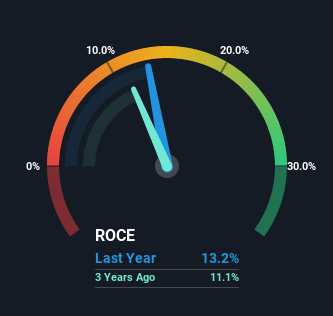
If you're not sure where to start when looking for the next multi-bagger, there are a few key trends you should keep an eye out for. In a perfect world, we'd like to see a company investing more capital into its business and ideally the returns earned from that capital are also increasing. Basically this means that a company has profitable initiatives that it can continue to reinvest in, which is a trait of a compounding machine. With that in mind, the ROCE of Quess (NSE:QUESS) looks decent, right now, so lets see what the trend of returns can tell us.
Understanding Return On Capital Employed (ROCE)
Just to clarify if you're unsure, ROCE is a metric for evaluating how much pre-tax income (in percentage terms) a company earns on the capital invested in its business. To calculate this metric for Quess, this is the formula:
Return on Capital Employed = Earnings Before Interest and Tax (EBIT) ÷ (Total Assets - Current Liabilities)
0.13 = ₹4.0b ÷ (₹54b - ₹23b) (Based on the trailing twelve months to June 2022).
So, Quess has an ROCE of 13%. That's a relatively normal return on capital, and it's around the 12% generated by the Professional Services industry.
Our analysis indicates that QUESS is potentially undervalued!

In the above chart we have measured Quess' prior ROCE against its prior performance, but the future is arguably more important. If you'd like, you can check out the forecasts from the analysts covering Quess here for free.
What The Trend Of ROCE Can Tell Us
While the current returns on capital are decent, they haven't changed much. The company has consistently earned 13% for the last five years, and the capital employed within the business has risen 73% in that time. 13% is a pretty standard return, and it provides some comfort knowing that Quess has consistently earned this amount. Over long periods of time, returns like these might not be too exciting, but with consistency they can pay off in terms of share price returns.
On a separate but related note, it's important to know that Quess has a current liabilities to total assets ratio of 43%, which we'd consider pretty high. This effectively means that suppliers (or short-term creditors) are funding a large portion of the business, so just be aware that this can introduce some elements of risk. Ideally we'd like to see this reduce as that would mean fewer obligations bearing risks.
The Key Takeaway
The main thing to remember is that Quess has proven its ability to continually reinvest at respectable rates of return. However, despite the favorable fundamentals, the stock has fallen 38% over the last five years, so there might be an opportunity here for astute investors. That's why we think it'd be worthwhile to look further into this stock given the fundamentals are appealing.
Quess does have some risks though, and we've spotted 1 warning sign for Quess that you might be interested in.
While Quess isn't earning the highest return, check out this free list of companies that are earning high returns on equity with solid balance sheets.
Valuation is complex, but we're here to simplify it.
Discover if Quess might be undervalued or overvalued with our detailed analysis, featuring fair value estimates, potential risks, dividends, insider trades, and its financial condition.
Access Free AnalysisHave feedback on this article? Concerned about the content? Get in touch with us directly. Alternatively, email editorial-team (at) simplywallst.com.
This article by Simply Wall St is general in nature. We provide commentary based on historical data and analyst forecasts only using an unbiased methodology and our articles are not intended to be financial advice. It does not constitute a recommendation to buy or sell any stock, and does not take account of your objectives, or your financial situation. We aim to bring you long-term focused analysis driven by fundamental data. Note that our analysis may not factor in the latest price-sensitive company announcements or qualitative material. Simply Wall St has no position in any stocks mentioned.
About NSEI:QUESS
Quess
Operates as a business services provider in India, South East Asia, the Middle East, and North America.
Flawless balance sheet, undervalued and pays a dividend.
Market Insights
Community Narratives


